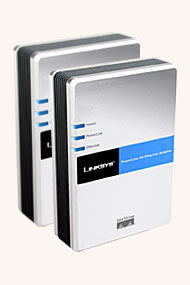
Page 4, ReadyNAS
I was using a pre11N Belkin wireless router, which should offer better range, higher throughput, and less interference than .11g WiFi. The Belkin router works just fine for doing fast data transfers and accessing the Internet from anywhere in the house. But it apparently couldn't deal with the demands of streaming multimedia in a high interference environment, even with my setting all the Belkin router tweaks that should have ensured robust delivery.
I am apparently not the only one experiencing this wireless drop out problem. The Net seems to be abuzz with this issue, as well. What this portends for the WiFi industry—and especially frustrated consumers—in a networked multimedia home is probably not good.
The solution to all my bits gone wild problems lay in Home Plug A/V PowerLine, and with the Linksys PLK200 network adapter in particular. Home Plug A/V PowerLine is a high speed ethernet standard for moving data around the home via your existing electrical wiring, with any available wall socket serving as a bit pouring outlet. This LAN scheme works, and it works beautifully.
The Linksys PLK200 kit for Home Plug A/V consists of two wall socket ethernet adapters (the minimum number required). The kit can be had for as little as $170 on-line, and frankly, it’s worth every penny in its ease of installation, maintenance, and no-drop signals.

The first question people often ask is can my neighbor tap into my electrical wiring and get a free Internet ride (as well as see all my data)? The answer is no, in much the same way they can’t tap in and get free electrical power. (Or are they? Hmm. Maybe that explains my high electric bills.) Your home wiring is terminated at the electric meter. Also, you can set the Linksys PLK200 to run 128-bit AES encryption as well as use password protection if you are completely P-Line paranoid.
The Home Plug A/V spec was designed to be fast enough and to offer such high QoS (quality of service) that it could run HDTV signals around the house wiring. In these two critical regards, Home Plug A/V differs and is superior to older HomePlug 1.1 products. Neither the two LAN specs, nor their respective gear, are interoperable. But the two PowerLine standards can comfortably cohabit within your walls and you can even run separate LANS over the wires.
The Linksys adapter is rather bulky at 2” thick, 4” wide, and 5.5” tall, and you should probably plan on giving up some wall socket real estate. It has three easy to see LEDs that indicate network status. PLK200 setup is fairly easy, but a word to the wise—If you have a laptop, use it for setup, and also do your password changes and data security business for all your adapters using the same wall socket before you move a Linksys adapter to its final wall socket location. You will save yourself much time and aggravation. After my doing all the setup, the Linksys PLK200 has since run flawlessly and never dropped a musical bit.
As for network speed, your wall wiring mileage will vary. (The theoretical max of Home Plug A/V is 200 megabit/sec, but really…) In my older apartment building I was seeing around 38-43 megabits/sec after all network overhead, more than enough for audio and also sufficient for streaming several HDTV channels.
For my audible money, Home Plug A/V is currently the only way to go in streaming A/V multimedia networks. You can run up to 256 Linksys PLE200 adapters in your home, which is probably enough, yeah? Additional Linksys PLE200 adapters can be had on-line for as low as $80 or so.
So there you have it. An energy saving, comprehensive storage and network solution that will keep your data safe, your bits moving ceaselessly, and perhaps most important for music lovers, a total media server solution that rivals stand-alone, digital high-end audio gear whose prices start at $5,000, at the least.
Meanwhile, let the arguments begin about what this finding portends. Will audio high-enders be forced to become computer geeks, forever arguing over the relative advantages of embedded LINUX over Windows, and debating the advantages of Rotational Vibration Feed Forward closed loop systems in disc drives? I can’t wait to see the binary fur fly.
21st, The VXM Network, https://vxm.com